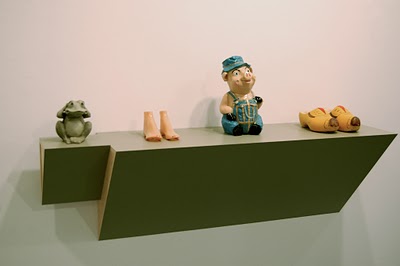
By Haim Steinbach. Click for more.
Once more from the indefatigable Junk Culture:
Haim Steinbach has been an influential exponent of art based on already existing objects. Since the late 1970’s Steinbach’s art has been focused on the selection and arrangement of objects, above all everyday objects.
This post is part of an occasional series.
Posted Under:
Things/Thinking
This post was written by Rob Walker on April 25, 2010
Comments Off on Pictures of Stuff, cont’d: Selection and arrangement
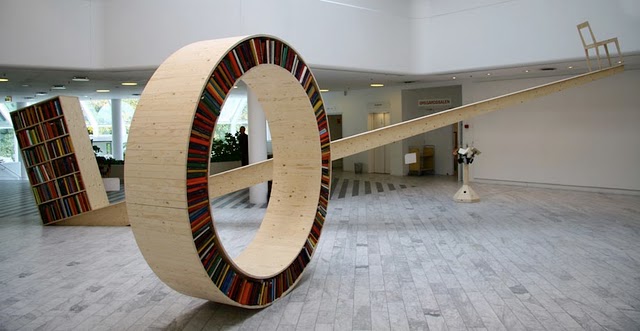
David Garcia Studio; Click for more.
Core77 picks up the circular bookshelf mentioned here in an earlier installment in this Murketing.com series, and notes the creator (whose name I didn’t have): David Garcia.
More to the point, Core77’s item cites this Dvice post, which in turn cites a blog called Bookshelf: The home of interesting bookshelves, bookcases and things that look like them — which is an absolute stunning trove of bookshelf/case-related images. I’ve just spent half an hour click through the archives and barely made a dent. In addition to several of the things from this series there’s a ton of stuff that should be in this series (and perhaps will be). It’s really an amazing blog.
In addition, one Bookshelf blog item is about a site called Lookshelves, whose proprietor asks people to send in pictures of their shelved books and answer a few questions. Meghan Beresford explains:
When I go to someone’s house, I am immediately drawn to their bookshelves. I want to know what they read (or buy), how they display their books, what’s well-thumbed and what’s in the darkish corners. I want to stumble into their secret interest in banjo, or ouija boards, or the Ottoman Empire. I love seeing that we’ve read the same thing, or being reminded that I meant to read that book, or seeing a bunch of books by an author I’ve never heard of right next to a writer I know and love. For all of these reasons, I love bookshelves.
More on this later, too.
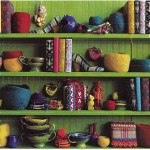 A couple of weeks ago now I mentioned Nicholson Baker’s piece, “Books as Furniture,” from the June 12, 1995 New Yorker. (Thx again Jim Rosenau.) Like much of Baker’s best work, it’s based on simply noticing something that seems curious — and going to fantastic lengths to explain what that something is all about.
A couple of weeks ago now I mentioned Nicholson Baker’s piece, “Books as Furniture,” from the June 12, 1995 New Yorker. (Thx again Jim Rosenau.) Like much of Baker’s best work, it’s based on simply noticing something that seems curious — and going to fantastic lengths to explain what that something is all about.
In this instance, what he noticed was how frequently mail-order catalogs for furniture and clothing other lifestyle-product companies featured, as casual props in their carefully staged photographs, books. Along the way he makes several observations that, in addition to being quite relevant to this site’s occasional series on the idea of the book, are also just flat-out wonderful.
Poring over catalogs from The Company Store, Crate & Barrell, Crabtree & Evelyn, Tweeds, J. Crew, etc., Baker spotted book after book. Though their titles were often illegible, and many seemed chosen more for the color of the spine than whatever was on their pages, it was nonetheless the case that these images were
surrounding printed fiction with life-size fictional rooms that resemble our own real rooms except that they are a good deal neater, costlier, and more literate….
There isn’t a self-help book or current best-seller to be seen, because the men and women who live in the rooms of the mail-order catalogues never read best sellers. In fact, they never read paperbacks.
This leads into a highly useful history of book display, going back to the first century, “when some books were still published – that is, multiply copied – on rolls (volumina), and stored on their sides” in armoire-like cabinets that were the precursors to the bookcase, “with little tags hanging from their ends which bore their titles.” A Pottery Barn catalog perused by Baker alludes to this history in the blurb for an armoire. “But can its copywriter truly believe that anyone is now going to keep a book collection behind the closed pine doors of a nine-hundred-and-ninety-nine-dollar cupboard?” He answers: No.
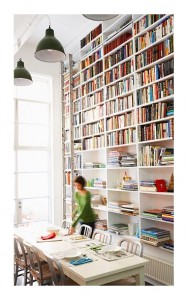
Catalog designers know perfectly well that books, if we are fortunate enough to own any, should be out there somewhere, visible, shelved in motley ranks or heaped on tables as nodes of compacted linearity that arrest the casual eye and suggest wealths of patriarchal, or matriarchal, learnedess.
Unlike other collectibles, books “represent a different order of plenitude,” Baker writes, one that encompasses “the camel caravans of thought-bearing time to read them through.” And he quotes William Gladstone arguing against a fashion for ornamental bookcases; those objects should remain plain, Gladstone says, because books “are themselves the ornament.”
Is the fate of this ornament at long last threatened? That’s been an undercurrent of this series, I suppose. Or maybe it’s more accurate to say that I think this series has been suggesting that the ornament will survive, but will also evolve. Whether books have a future or not, I think the idea of the book does.
More on this tomorrow.
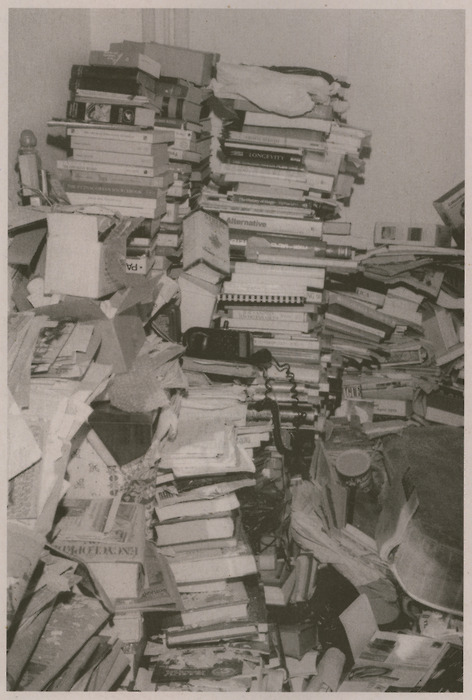
Public Collectors says: “Scanned from The Plan by Michael Schmelling, 2009, J&L Books, Atlanta. ‘Between 2003 and 2005 Michael Schmelling photographed various homes and apartments in the company of Disaster Masters, a New York-based agency that specializes in cleaning homes and counseling hoarders.’” Via Dinosaurs and Robots.
This would be a non-joyous version of clutter. (Joy and clutter also discussed here, as part of this series; and here on the Aesthetics of Joy blog.)
Posted Under:
Things/Thinking
This post was written by Rob Walker on April 22, 2010
Comments Off on Pictures of stuff, cont’d: The not-appealing hoard
Marginal Revolution points to this:
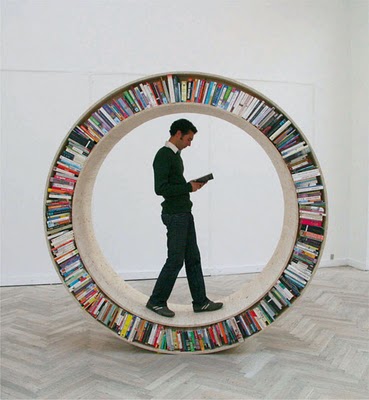
No attribution at present for artist/designer. Click pic for more.
That’s from a blog called Bioephemera, which asks its readers if anybody knows who made thing [UPDATE April 23,2010: Core77 mentions this object and its creator: David Garcia], and also points to this somewhat similar item:
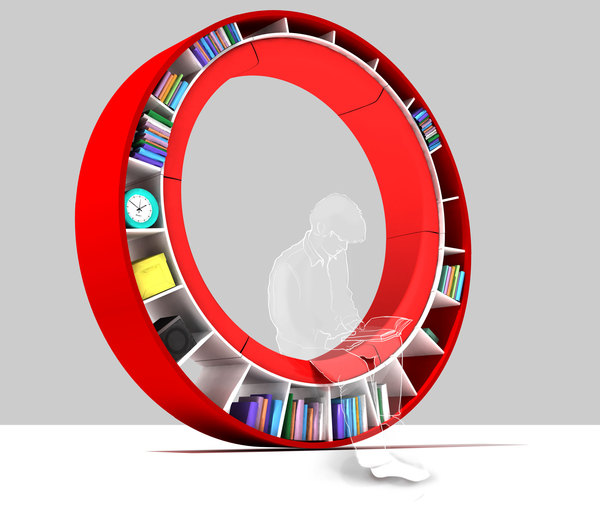
By Irina Zhdanova, click for detiails.
This post is part of a series.
I’d been meaning to mention that Lisa Congdon’s Collection A Day blog, mentioned earlier here, is still awesome. The perfect excuse: the below, via Swiss Miss.
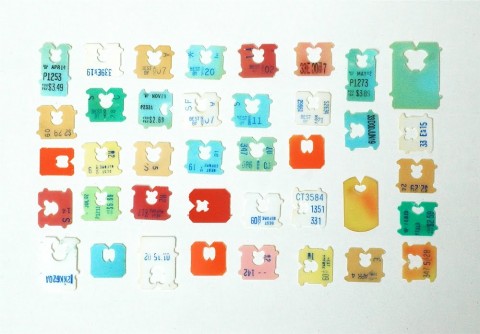
Day 107: Bread Bag Ties. Click for more.
This post is part of a series.
Posted Under:
Things/Thinking
This post was written by Rob Walker on April 18, 2010
Comments Off on Pictures of Stuff, cont’d: Bread Bag Ties
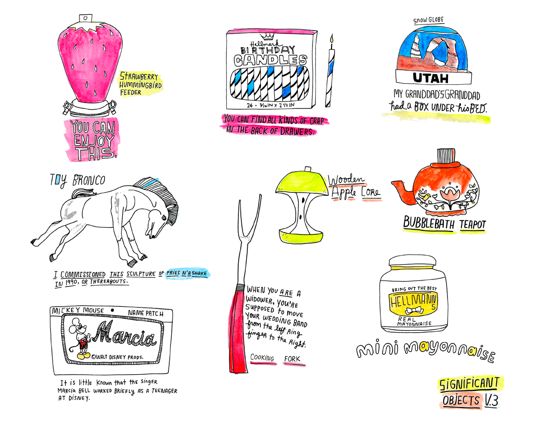
11×14; edition of 500: $50!
I teased this last week — and now it’s here! We’re really excited to announce the latest Significant Objects team-up, resulting in thoroughly affordable art, and another way to support v3 beneficiary Girls Write Now.
The prints you see on this page are available in limited editions from 20×200, Jen Bekman’s online project that sells a dazzling array of prints from an impressive roster of artists, all priced to meet a mission of making art available to all.
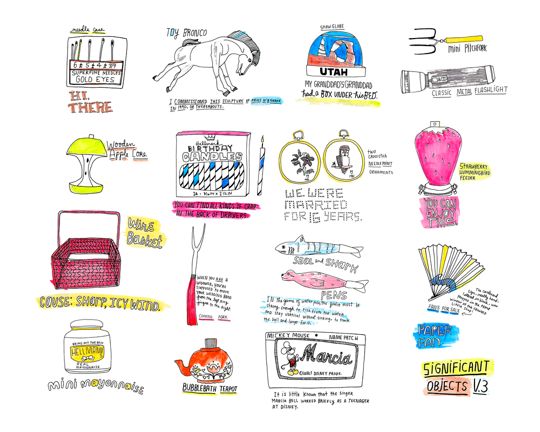
16×20; edition of 20: $200!
The artist is Kate Bingaman-Burt, whose delightful book Obsessive Consumption was just published, and whose combination of thoughtfulness about consumer behavior and mad drawing skills make her our perfect match.
All these prints are created using archival pigment inks on 100% cotton rag paper with a matte finish.
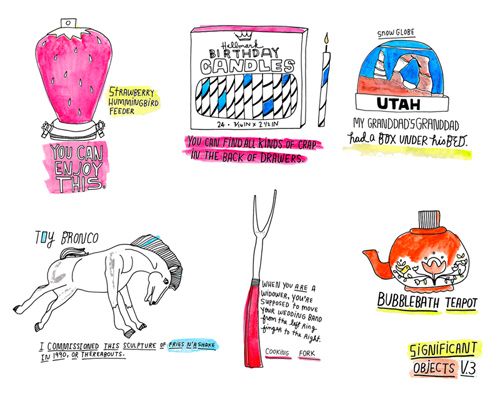
8×10; edition of 200: $20!
Proceeds from the sale of these prints will benefit Girls Write Now, contributing to Significant Object’s grand total donation.
Girls Write Now provides guidance, support, and opportunities for New York City’s underserved or at-risk high school girls, enabling them to develop their creative, independent voices, explore careers in professional writing, and learn how to make healthy choices in school, career and life.
Read more
Posted Under:
Artists,
Pleasing,
Things/Thinking
This post was written by Rob Walker on April 17, 2010
Comments Off on Signficant Objects X Kate Bingaman-Burt X 20×200 — now available!
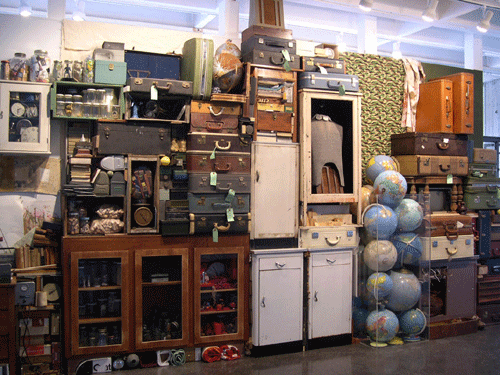
Doug Bell. Click for more.
Via Junk Culture, yet again:
Artist Doug Bell makes sculptures that range from small table-top sized, manipulated found object pieces, to life size tableaus and wall sized installations. The installations can be made up of hundreds of objects…. His work is a reflection of his need to make order out of chaos and give meaning to the incoherent.
Part of a series.
Posted Under:
Artists,
Things/Thinking
This post was written by Rob Walker on April 16, 2010
Comments Off on Pictures of Stuff, cont’d: Clutter? Joy?
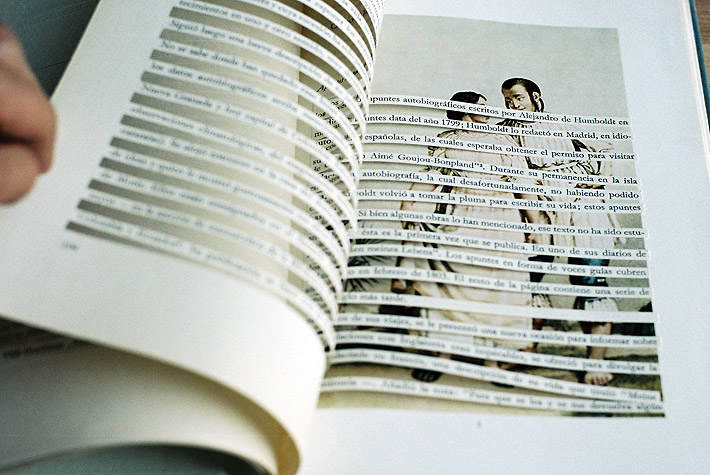
By Onlab. Click for more.
Via ffffound. Part of a series.
Posted Under:
Things/Thinking
This post was written by Rob Walker on April 16, 2010
Comments Off on Books, the idea: Carefully sliced objects
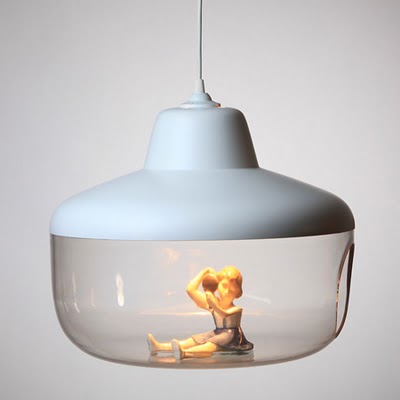
By Chen Karlsson. Click for more.
Junk Culture: “Stockholm design studio Chen Karlsson created a lamp where treasured objects can be exhibited inside a transparent tank beneath the light source. Called Favourite Things, the design is meant to spotlight objects of importance to the owner.”
Thx: Gabriel. Seen also on Significant Objects. Part of an occasional series.
Posted Under:
Things/Thinking
This post was written by Rob Walker on April 13, 2010
Comments Off on Pictures of Stuff, cont’d: Spotlight for stuff
Vis-a-vis hoarding — discussed earlier here and to some extent here (and also in a post on aesthetics of joy) — Salon’s Heather Havrilesky describes the effect that watching hoarding shows has had on her. For example:
[W]hen I watch these hoarders, kvetching over this bag of yarn or that muffin tin, I think about the old black-and-white photographs you sometimes find at flea markets and estate sales, photos of a couple smiling on their couch, or of a gathering of women in a backyard, holding a miserable-looking baby, or of a girl sitting on a swing, a dog wandering through the grass nearby.
These are someone else’s memories that were packed away in boxes, in an attic or a basement, and when that person died, no one wanted them. No kids, no sisters, no spouse, no second cousins showed up and dragged these photographs away — they were left in a pile somewhere, and now here they are, being sorted through by total strangers. How much stuff will I force my kids to sort through? How much of it will immediately be identified as worthless? How much of my stuff might end up like this, drifting through the hands of strangers? When you think about your stuff that way, 90 percent of it suddenly begs to be boxed up and driven to Goodwill immediately.
I know what she’s saying, although when I follow this line of thought it usually ends with me wanting to obliterate all material traces of myself, rather than cart them to Goodwill so they can end up precisely the Stuff Ecosystem described here, to be mused over by strangers after I’m going.
But possibly that’s just me.
Spotted in the April 2010 issue of The Atlantic (go buy a copy so they don’t make me cease-and-desist this image!). Part of a series.

Posted Under:
Things/Thinking
This post was written by Rob Walker on April 12, 2010
Comments Off on Books, the idea, cont’d: Amusing Atlantic cartoon
I mentioned that I’d have a couple of bits of news from the Significant Objects project that might be of interest to Murketing readers. Here’s one bit.
Today’s story (part of our Paola Antonelli team up, co-published on Core77) is by Matt Brown. I’ve mentioned him a couple of times here in the past; a post on Metafilter described him as a “design fiction enthusiast,” which sounded close enough to my interest in imaginary brands that I was curious. And his work just completely blows me away: He has a peculiar genius for devising alternative histories for random, mass-produced stuff, and expressing this design fiction with both words and, more unusually, completely invented packaging. (In fact he’s now doing a series for Core77, Design Fancy.)
We knew we wanted him involved in Significant Objects. And when Paola Antonelli presented me with her objects, there was one that struck me as being perfect for Brown. This:

What is it? Well, Anotelli wouldn’t tell me. Turns out Brown, as I suspected, had an answer. It’s a “crumpter.”
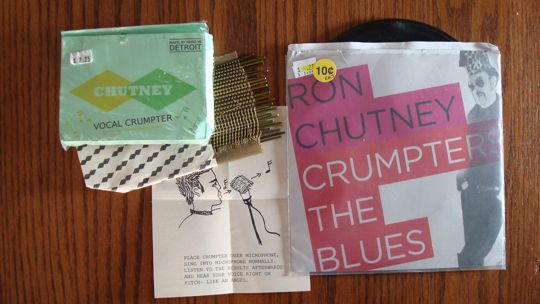
A crumpter, it turns out, is a sort of analog precedent to autotune. Never heard of that? Oh, well then, please read the story over at S.O.
And yes, all the collateral material Brown created is part of the auction.
We’ve sold a mystery object, we’ve sold a story that was itself an object, and now an object whose story is told in part through its packaging.
For obvious reasons the discussion of the idea of books has focused quite heavily on the e-variety these last few days, as speculation abounds over The Meaning of the iPad For The Printed Word.
The Telegraph reports on a book that will have a sort of instant sequel “assembled from the best comments by readers of” the author’s Website. A publishing type who is involved comments:
With devices like the iPad nearly at our shores and more routes for communication than ever before, I believe that especially in non-fiction, the distance between the author and reader should start to disappear. Authors will become more like curators and take influence from their readers’ suggestions during and after they have written their work.
Meanwhile, Nicholas Carr suggests that what we’re headed for is books becoming multimedia apps, in a sort of post-reader world. He quotes some other publishing-world guy:
“The definition of the book itself seems up for grabs,” he said at a recent media industry powwow. Unlike traditional e-book readers, which had a rather old-fashioned attachment to linear text, the iPad opens the doors to incorporating all sorts of “cool stuff,” Makinson continued. “We will be embedding audio, video and streaming into everything we do.” He foresees sprinkling movie clips among Jane Austen’s paragraphs in future editions of “Pride and Prejudice.”
Hm. What do you think?
Perhaps I’ll “curate” the best of your responses into a follow-up post!
With video?
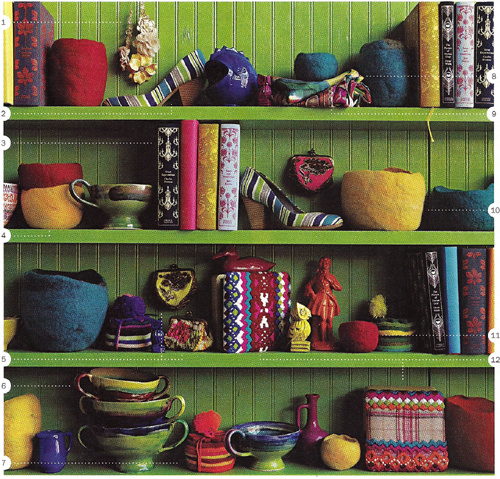
Via Jezebel, click for more.
In a thoughtful comment to a December 2009 post on Significant Objects (in which I noted examples of art made from books, and ruminated on the possibilities of “upcycling with words”), Jim Rosenau mentioned a Nicholson Baker New Yorker essay called “Books As Furniture.” I finally got around to tracking that down and reading it this weekend, and I must thank Mr. Rosenau. The piece, from 1995, is amazing.
It’s in the New Yorker archive, here, but I guess you have to be a subscriber to access it. It’s going to take me more than one post to deal with all the great observations in this essay (are you out there RAOJ?) but by chance there’s opening to get started today.
In a nutshell, Baker starts noticing the books used as props in home decor catalogs, and looks into it. And, you know, he does that Nicholson Baker thing, of learning a shocking amount, conveying it to us with one insight after another, and basically just making the whole experience a reading pleasure. More specifics in the days ahead, but in the short term I happened to become aware by coincidence just today that Jezebel (a site I visit rarely, not that there’s anything wrong with it) has a kind of recurring feature that involves … scrutinizing catalogs. The image at the top of this post, for instance, is from an Anthropologie catalog.
You’ll notice, of course, the books, looking quite pleasing there with all the other stuff on that just-so shelf. But those aren’t props (or at least not just props) like the books that Baker noticed in various catalogs: Anthropologie evidently actually sells ’em:
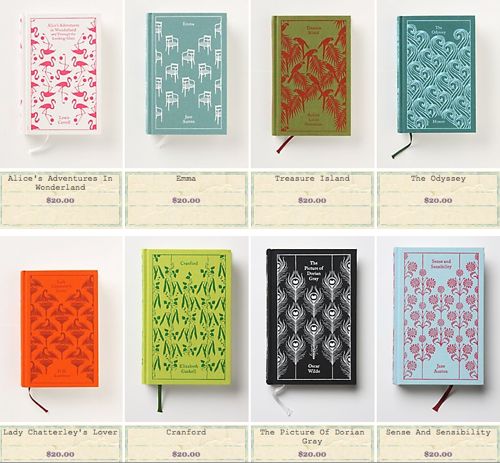
Anthropologie book selection. Click for more.
And let’s face it: They look great.
More on Baker’s 1995 piece as this series continues.




 "
"































 Kim Fellner's book
Kim Fellner's book  A
A